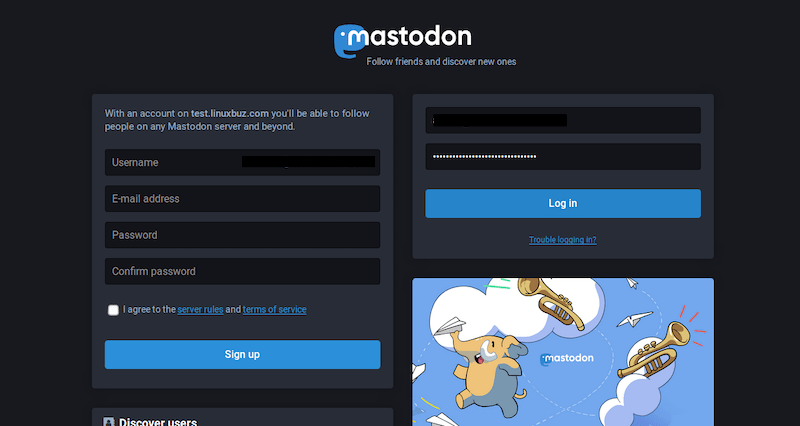How To Install Mastodon on Ubuntu 22.04 LTS

In this tutorial, we will show you how to install Mastodon on Ubuntu 22.04 LTS. For those of you who didn’t know, Mastodon is an open-source decentralized social network. It offers microblogging features that allow you to follow other users and post messages and images with Mastodon. Its is written in Ruby and JavaScript and its open-source nature makes sure that it remains open for anyone to use privately and securely. Anyone can create a Mastodon server and build their own communities with friends. Additionally, Mastodon is supported by and available through multiple apps for iOS, Android, and other platforms
This article assumes you have at least basic knowledge of Linux, know how to use the shell, and most importantly, you host your site on your own VPS. The installation is quite simple and assumes you are running in the root account, if not you may need to add ‘sudo‘ to the commands to get root privileges. I will show you the step-by-step installation of the Mastodon social networking on Ubuntu 22.04 (Jammy Jellyfish). You can follow the same instructions for Ubuntu 22.04 and any other Debian-based distribution like Linux Mint, Elementary OS, Pop!_OS, and more as well.
Prerequisites
- A server running one of the following operating systems: Ubuntu 22.04, 20.04, and any other Debian-based distribution like Linux Mint.
- It’s recommended that you use a fresh OS install to prevent any potential issues.
- SSH access to the server (or just open Terminal if you’re on a desktop).
- A
non-root sudo useror access to theroot user. We recommend acting as anon-root sudo user, however, as you can harm your system if you’re not careful when acting as the root.
Install Mastodon on Ubuntu 22.04 LTS Jammy Jellyfish
Step 1. First, make sure that all your system packages are up-to-date by running the following apt commands in the terminal.
sudo apt update sudo apt upgrade sudo apt install software-properties-common dirmngr apt-transport-https ca-certificates redis-server curl gcc g++ make imagemagick ffmpeg libpq-dev libxml2-dev libxslt1-dev file git-core libprotobuf-dev protobuf-compiler pkg-config autoconf bison build-essential libssl-dev libyaml-dev libreadline-dev libidn11-dev libicu-dev libjemalloc-dev zlib1g-dev libncurses5-dev libffi-dev libgdbm-dev
Step 2. Installing Node.js
By default, Node.js is not available on Ubuntu 22.04 base repository. Now run the following command below to add the NodeSource repository to your Ubuntu system:
wget -qO- https://deb.nodesource.com/setup_16.x | sudo -E bash
After adding the NodeSource repository to your system, install the Node.js using the Apt package manager:
sudo apt install nodejs
Step 3. Installing PostgreSQL.
By default, PostgreSQL is available on Ubuntu 22.04 base repository. Now run the following command below to install the latest version of PostgreSQL to your system:
sudo apt install postgresql postgresql-contrib
Once successfully installed, enable PostgreSQL (to start automatically upon system boot), start, and verify the status using the commands below:
sudo systemctl enable postgresql sudo systemctl start postgresql sudo systemctl status postgresql
Secure PostgreSQL.
By default, PostgreSQL created a user called “postgres” and is not password secured. Now we run the following command to generate a password for the “postgres” user account:
sudo passwd postgres
Next, create a user for Mastodon with the following command:
postgres=# CREATE USER mastodon CREATEDB;
Then, exit from the PostgreSQL shell with the following command:
postgres=#exit
Step 4. Installing Ruby.
First, you will need to create a new system user to run the Mastodon server. You can create it with the following command:
adduser --disabled-login --gecos 'Mastodon Server' mastodon
Next, log in to mastodon user with the following command:
su - mastodon
After that, download the Ruby shell script file installer to your Ubuntu system:
curl -fsSL https://github.com/rbenv/rbenv-installer/raw/HEAD/bin/rbenv-installer | bash
Next, update the path environment using the following shell script command:
echo 'export PATH="$HOME/.rbenv/bin:$PATH"' >> ~/.bashrc echo 'eval "$(rbenv init -)"' >> ~/.bashrc source ~/.bashrc
Finally, run the following command below to install the latest version of Ruby on Ubuntu:
rbenv install ruby 3.1.2 rbenv global 3.1.2
Now check the Ruby version using the command below:
ruby --version
Step 5. Configure Mastodon.
Now we log in to Mastodon user and download the Mastodon Git repository with the following command below:
su - mastodon git clone https://github.com/tootsuite/mastodon.git ~/live cd ~/live
Next, install all the dependencies with the following command:
bundle config deployment 'true' bundle config without 'development test' bundle install -j$(getconf _NPROCESSORS_ONLN) yarn install --pure-lockfile
Then, we set up the Mastodon with the following command below:
RAILS_ENV=production bundle exec rake mastodon:setup
During the installation process, you will be asked several questions:
Your instance is identified by its domain name. Changing it afterward will break things. Domain name: mastodon.example.com Single user mode disables registrations and redirects the landing page to your public profile. Do you want to enable single user mode? No Are you using Docker to run Mastodon? no PostgreSQL host: /var/run/postgresql PostgreSQL port: 5432 Name of PostgreSQL database: mastodon_apps Name of PostgreSQL user: mastodon Password of PostgreSQL user: Database configuration works! ???? Redis host: localhost Redis port: 6379 Redis password: Redis configuration works! ???? Do you want to store uploaded files on the cloud? No Do you want to send e-mails from localhost? yes E-mail address to send e-mails "from": Mastodon <notifications@mastodon.example.com> Send a test e-mail with this configuration right now? no This configuration will be written to .env.production Save configuration? Yes Now that configuration is saved, the database schema must be loaded. If the database already exists, this will erase its contents. Prepare the database now? Yes All done! You can now power on the Mastodon server ???? Do you want to create an admin user straight away? Yes Username: admin E-mail: admin@idroot.us You can login with the password: 159e442001120169eafa39849303f10 You can change your password once you login.
Once is done, exit from the Mastodon user with the following command:
exit
Step 6. Configure Nginx as a Reverse Proxy.
Now we install Nginx and Certbot to your Ubuntu system. First, add the Certbot repository using the following command below:
add-apt-repository ppa:certbot/certbot
After that, update the repository and install Certbot with Nginx by running the following command:
sudo apt update sudo apt install nginx python-certbot-nginx
Next, copy the Nginx configuration file from the Mastodon directory to Nginx with the following command:
cp /home/mastodon/live/dist/nginx.conf /etc/nginx/sites-available/mastodon.conf ln -s /etc/nginx/sites-available/mastodon.conf /etc/nginx/sites-enabled/
By default, the Mastodon Vhost configuration file is configured with the domain your-example-domain.com. So you will need to replace the example.com domain with your domain name in the file mastodon.conf. You can replace it with the following command:
sed -i 's/example.com/mastodon.your-domain.com/g' /etc/nginx/sites-enabled/mastodon.conf
Finally, restart the Nginx service to apply the configuration:
sudo systemctl restart nginx
Next, download the Let’s Encrypt free SSL certificate and configure Nginx to use this certificate by running the Certbot command:
certbot --nginx -d mastodon.your-domain.com
Step 7. Create Systemd Service for Mastodon.
Now we create systemd a service file for Mastodon. To do so, copy the systemd service templates from the Mastodon directory:
cp /home/mastodon/live/dist/mastodon-web.service /etc/systemd/system/ cp /home/mastodon/live/dist/mastodon-sidekiq.service /etc/systemd/system/ cp /home/mastodon/live/dist/mastodon-streaming.service /etc/systemd/system/
Then, start all services and enable them to start after reboot with the following command:
sudo systemctl start mastodon-web sudo systemctl start mastodon-sidekiq sudo systemctl start mastodon-streaming sudo systemctl enable mastodon-web sudo systemctl enable mastodon-sidekiq sudo systemctl enable mastodon-streaming
Step 8. Configure Firewall.
Now we set up an Uncomplicated Firewall (UFW) with Apache to allow public access on default web ports for HTTP and HTTPS:
sudo ufw allow OpenSSH sudo ufw allow 'Apache Full' sudo ufw enable
Step 9. Accessing Mastodon Web Interface.
Once successfully installed, open your web browser and access the Mastodon installation wizard using the URL https://mastodon.your-domain.com. You will be redirected to the following page:

Congratulations! You have successfully installed Mastodon. Thanks for using this tutorial for installing Mastodon social network on Ubuntu 22.04 LTS Jammy Jellyfish system. For additional help or useful information, we recommend you check the Mastodon website.